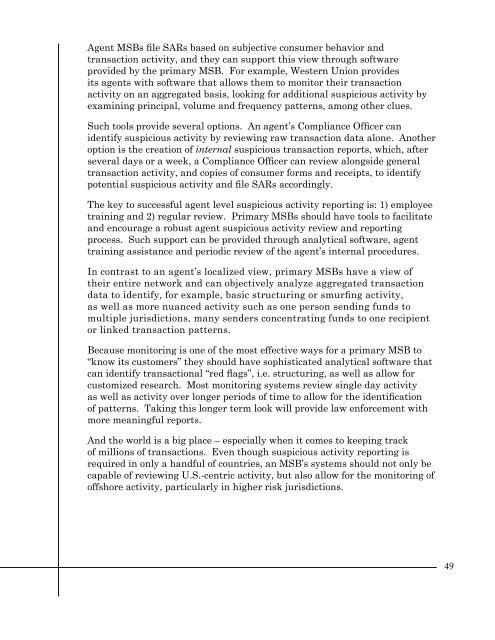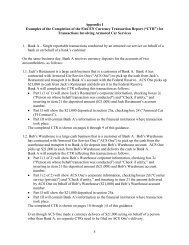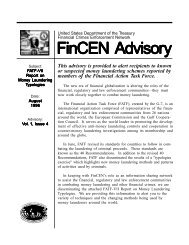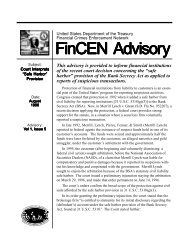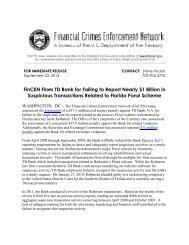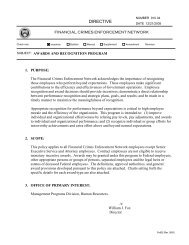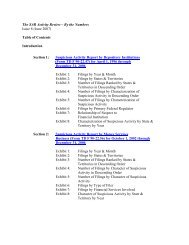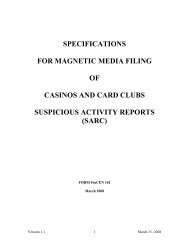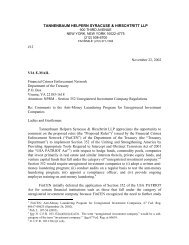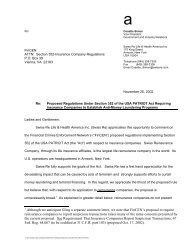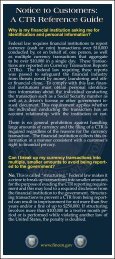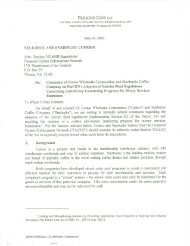FinCEN SAR Activity Review, Trends, Tips & Issues, Issue 10
FinCEN SAR Activity Review, Trends, Tips & Issues, Issue 10
FinCEN SAR Activity Review, Trends, Tips & Issues, Issue 10
Create successful ePaper yourself
Turn your PDF publications into a flip-book with our unique Google optimized e-Paper software.
Agent MSBs file <strong>SAR</strong>s based on subjective consumer behavior and<br />
transaction activity, and they can support this view through software<br />
provided by the primary MSB. For example, Western Union provides<br />
its agents with software that allows them to monitor their transaction<br />
activity on an aggregated basis, looking for additional suspicious activity by<br />
examining principal, volume and frequency patterns, among other clues.<br />
Such tools provide several options. An agent’s Compliance Officer can<br />
identify suspicious activity by reviewing raw transaction data alone. Another<br />
option is the creation of internal suspicious transaction reports, which, after<br />
several days or a week, a Compliance Officer can review alongside general<br />
transaction activity, and copies of consumer forms and receipts, to identify<br />
potential suspicious activity and file <strong>SAR</strong>s accordingly.<br />
The key to successful agent level suspicious activity reporting is: 1) employee<br />
training and 2) regular review. Primary MSBs should have tools to facilitate<br />
and encourage a robust agent suspicious activity review and reporting<br />
process. Such support can be provided through analytical software, agent<br />
training assistance and periodic review of the agent’s internal procedures.<br />
In contrast to an agent’s localized view, primary MSBs have a view of<br />
their entire network and can objectively analyze aggregated transaction<br />
data to identify, for example, basic structuring or smurfing activity,<br />
as well as more nuanced activity such as one person sending funds to<br />
multiple jurisdictions, many senders concentrating funds to one recipient<br />
or linked transaction patterns.<br />
Because monitoring is one of the most effective ways for a primary MSB to<br />
“know its customers” they should have sophisticated analytical software that<br />
can identify transactional “red flags”, i.e. structuring, as well as allow for<br />
customized research. Most monitoring systems review single day activity<br />
as well as activity over longer periods of time to allow for the identification<br />
of patterns. Taking this longer term look will provide law enforcement with<br />
more meaningful reports.<br />
And the world is a big place – especially when it comes to keeping track<br />
of millions of transactions. Even though suspicious activity reporting is<br />
required in only a handful of countries, an MSB’s systems should not only be<br />
capable of reviewing U.S.-centric activity, but also allow for the monitoring of<br />
offshore activity, particularly in higher risk jurisdictions.<br />
49


